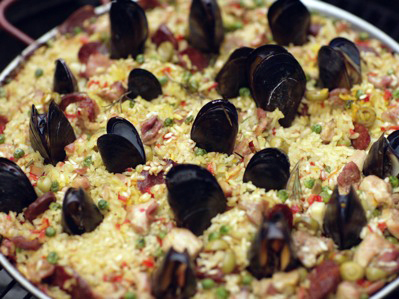
rice, l
(article, Kathleen Bauer)
When I told my mother that we were planning to make paella, a rice dish, on the grill, she asked, "But how are you going to do that? Won't it fall through?" With visions of rice grains balanced precariously on the grating, I explained that paella is cooked in a paellera, a wide, shallow carbon-steel pan with handles on each side. I've also used a wide frying pan on the stove, but I prefer to cook paella on the grill; cooking this dish over plenty of smoke imparts an incredible flavor. A one-pot meal combining rice, vegetables, broth, and protein, paella is perhaps the definitive dish of Spain. But it’s tricky to find a version that brings out the complex flavors of the ingredients while maintaining the textural integrity of what is basically a simple rice dish. This version of paella makes the grade. [%image rice width=400 float=left caption="Mussels stood on end add the finishing touch to this paella cooked on the grill."] Opinions about the origins of paella are as mixed as the dish itself. Some sources say the basic recipe of olive oil, salt, rice, and broth is several centuries old, while others trace paella only to the mid-19th century. Originally cooked over wood-burning fires and served straight from the pan to farm workers after a hard day’s labor, paella was made with rice and whatever other ingredients were on hand — rabbit, snails, or beans. The most familiar contemporary version may be paella made with chicken and shellfish, but really, the choice of flavors is up to you. Short-grained rice has always been the foundation of paella, usually rice from the Valencia region of Spain, which can absorb three times its volume in liquid. Bomba is a similar Spanish rice that’s easier to come by in the U.S., although arborio or any rice used for risotto will do. The only other paella essentials are saffron and olive oil. [[block(sidebar). h1. The gear Kathleen uses a 15-inch paella pan, a gift from friends. Buy your own — and stock up on chorizo and short-grained Spanish rice — at The Spanish Table or La Tienda. ]] I often make paella with Spanish chorizo, a salami-style sausage spiced with paprika. It's available online. Additionally, Bay Area chef and charcuterie specialist Paul Bertolli has just released his own version of this specialty, salametto piccante, which I find indistinguishable from the Spanish varieties. It's important never to substitute fresh-ground Mexican-style chorizo sausage, however. The chile in it will overwhelm the delicate flavors of the paella. Along with the chorizo, I assemble some smoked paprika, green olives (the anchovy-stuffed Spanish ones, if possible), and fresh seafood. Plus some chicken thighs, a rich stock, colorful bell peppers (I prefer red or yellow), and the essential onions and garlic. Once the charcoal grill is lit, I’m in the kitchen, chopping vegetables and steeping the saffron in a dry white wine to soften it and bring out its amazing flavor and color. When the guests have arrived and we’ve got a nice bed of hot coals, it’s time to herd everyone out to the grill (wine glasses in hand) for the evening’s entertainment. The show? Put the paella pan on the grill. Drizzle in a bit of olive oil and sauté the vegetables (this step is called the sofrito). Add the chicken and fry until it browns, then add the chorizo to warm it up. Pour in the rice and stir for a couple of minutes. Then pour in the stock and the saffron in wine, add the olives, and cover it with the lid of the grill to let that wonderful smoke infuse the dish. A few minutes before serving, add mussels or clams and let them cook briefly. Lately, we’ve been working hard in our paella endeavors to achieve a good caramelized bottom crust, known as the socarrat. The trick seems to be in getting just the right ratio of stock to rice, so that the rice softens but maintains a slight crunch. It should be dry enough to form that crust and yet not burn from the heat of the coals. [[block(sidebar). h1.Featured recipe]] Paella is terrific for dinner parties because it feeds a crowd and it’s fun to serve straight from the pan. You don't really need anything else with it, except maybe a green salad and an earthy red wine or a chilled rosé. That and a little candlelight, and you’ve got yourself a showstopper. p(bio). Kathleen Bauer is a freelance art director and blogs at GoodStuffNW. A native Oregonian, she lives in Portland.

rice, l

reference-image, l